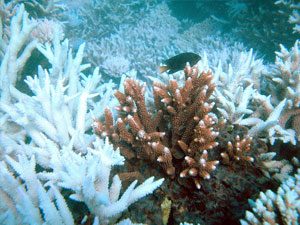Coral reefs are home to some of the most diverse ecosystems on the planet. The intricate shapes and bright colors found on reefs can be reminiscent of the Dr. Seuss books that we all read as kids. They are also sometimes called the rainforests of the sea, mostly because coral reefs rival tropical rainforests in biodiversity, but also because of the obvious biological complexities that can be observed on any part of a reef. One of these complexities can be viewed in the form of symbiotic relationships, which occur between all kinds of reef-dwelling (or building!) organisms.
There are three main types of symbiotic relationships found in nature: mutualism, commensalism, and parasitism. In blog posts that I will update over the next few months, I will outline how each of these relationships are prevalent on coral reefs while providing examples of each, how human impact is affecting them, and how this will ultimately affect coral reef ecosystems on a global scale.
The first type of symbiotic relationship, and the main focus of this post, is mutualism. In these kinds of interspecific relationships, both (or all) organisms involved benefit from the interactions. There are numerous examples of mutualism on coral reefs. One is the relationship that cleaner shrimp (Lysmata anboinensis) have with many species of larger ‘client’ fish, who come to the shrimp to be cleaned of parasites and dead skin, which the shrimp then eat¹. If you’ve ever seen Finding Nemo, the character Jacques was actually a cleaner shrimp! This is a prime example of a mutualistic relationship; the shrimps benefit because they get food while the fish benefit because they get rid of possibly harmful parasites and dead skin. This relationship is pictured below.

Image 1: L. anboinensis ‘works’ on a yellow-edged moray eel (Gymnothorax flavimarginatus) to rid the fish of parasites and dead tissues. Credit: Jesse Cancelmo
Another example of mutualism on reefs is one that is vital to the health of the reef and all its inhabitants: the relationship that corals have with zooxanthellae. Corals are animals that consist of vast carbonate (limestone) skeletons produced by tiny individual polyps, which comprise the actual animal part of the coral. Zooxanthellae (dinoflagellates that live in symbiosis with many types of invertebrates) live within the polyp tissue and use carbon dioxide and H2O from the coral to carry out photosynthesis. They in turn provide the coral with sugars, lipids, and oxygen for growth and the continuation of the cycle of cellular respiration².
You might have heard of something called ‘coral bleaching’ – this is the phenomenon by which corals lose their symbiotic zooxanthellae due to drastically changing ocean conditions (including temperature, salinity, and acidity). Coral bleaching is characterized by white, thin-looking corals as opposed to brown or greenish corals that are fuller in composition (pictured below).

Image 2: Acropora coral experiences bleaching on the Great Barrier Reef. Credit: Prof. Ove Hoegh-Guldberg: Chair, CRTR Coral Bleaching Working Group; http://www.gefcoral.org/en-us/targetedresearch/bleaching.aspx
Because corals are completely dependent on zooxanthellae, losing this critical relationship is a blow to any reef that experiences bleaching. Bleached coral can recover, but only if zooxanthellae return to the corals in a relatively short amount of time (usually a few days). After this, the coral dies and becomes a part of the extensive skeletal structure of the reef. Although reef growth requires the accumulation of coral carbonate skeleton, infinitely more important is the presence of live coral, which provides many ecological benefits beyond the zooxanthellae.

Figure 1: Mean survivorship of 4 prey fish associated with different habitat treatments (n = 6 for each treatment): 1) healthy, 2) bleached, 3) dead, 4) algal covered, and 5) control (no predator) after being exposed to a predator for 75 h. Mean SE = 6.5%, 4.3%, 4.2%, and 3.7%.³
The very possible continued global bleaching of coral reefs not only threatens corals themselves, but also the many species of fish and other marine creatures that make reefs their home (this in and of itself is an example of mutualism). Reefs serve many roles, including the role of protector from predators for many species. Many predators use contrasting coloration to find prey, and for this reason many prey species have adapted to resemble certain parts of reefs. Since bleaching changes the color of corals, this can make coral-dwellers more susceptible to predation3. The structural degradation of reefs can also attribute to greater predation rates, since prey species won’t be able to hide in the same nooks and crannies that they have in the past. See Figure 1 for an idea as to how much prey species rely on corals.
Since close to a quarter of marine biodiversity depends on reefs in some way4, it is vital that their structural and functional integrity remain intact. Reefs provide some of the greatest examples of mutualism in nature, and their existence as a resource for biologists and other researchers remains something worth protecting.
Resources:
1 Lysmata amboinensis: WAZA: World Association of Zoos and Aquariums
2 NOAA’s National Ocean Service: Diagram of coral and zooxanthellae relationship
3 Darren J. Coker, Morgan S. Pratchett, Philip L. Munday; Coral bleaching and habitat degradation increase susceptibility to predation for coral-dwelling fishes. Behav Ecol 2009; 20 (6): 1204-1210. doi: 10.1093/beheco/arp113
4 Nancy Knowlton. Corals and Coral Reefs. Comp. The Ocean Portal Team. N.d.

